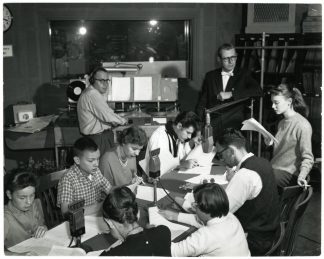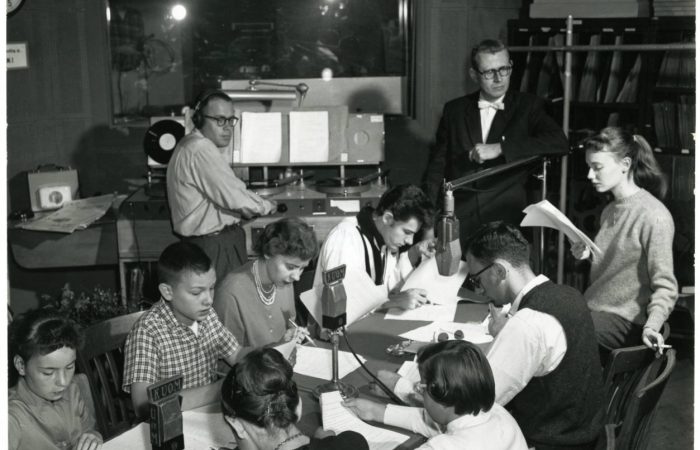By Allison Campbell-Jensen
The University Archives holds about 11,000 audio recordings from the University of Minnesota’s radio station KUOM and other events on campus. Because they were recorded from 1939 to 1993 on reel-to-reel equipment, however, as that recording method became obsolete, these recordings were effectively silenced.
Now almost 5,000 of them have been restored to audible life, thanks to funding from the Council on Library and Information Resources and Minnesota Historical and Cultural Heritage Grants.
Decades of recordings
The University of Minnesota’s radio station was licensed as WLB Jan. 13, 1922. When radio naming conventions changed in the 1940s, it became KUOM. University Archives and the Libraries will celebrate that centennial when Rebecca Toov leads First Fridays on Feb. 4, 2022.
During the decades, the radio station created educational programming — it was housed administratively under University Extension. Minnesota School of the Air aired for 40 years, providing classroom instruction for K-12 students. Curriculua would be developed and distributed; then students in classrooms around the state would tune in for the programs. In 1946, when a polio epidemic closed schools and kept students at home, KUOM created programming to address the educational needs and a community space for entertainment and to get up-to-date information on the epidemic.
Governors, legislators, and University faculty also spoke on KUOM programs, along with national figures. For example, a 1968 recording featured famed civil rights activist Fannie Lou Hamer speaking about, among other things, violent attacks against her and others seeking to help impoverished Black people vote in Jim Crow Mississippi.
Today, says University Archivist Erik Moore, students might use these radio programs to revisit the 1966 interviews with people affected by changes in the West Bank. Over about five years, he says, people living in neighborhoods saw huge changes because of three developments: Interstate 35W; the Cedar-Riverside high-rises, and the creation of the West Bank campus. Many were displaced and the character of the area changed. Today, we can hear their stories in their voices by listening to the radio program A Community You May Not Know… The West Bank.
Steps to digitized audio
It’s a time-consuming process, Moore says, to transform the audiotapes into useful resources. First, a catalog record must be made with whatever metadata is available. “Sometimes it’s a lot and sometimes it’s vague, depending on what’s written on the cardboard case or included on a cue sheet,” Moore says.
Fortunately, along with the 11,000 audio reels, University Archives has all the administrative records, program logs, scripts, and program planning that were preserved. These paper records often help reveal what’s on an audio reel, Moore says. “Sometimes we will have a question mark about what’s on it, so we have to listen to it when it comes back.”
After pulling tapes, packing them, and making shipping manifests, the reel-to-reel tapes are sent to a vendor, who prefers to deal in large batches of hundreds of tapes at a time. Then there are no shortcuts: the tapes have to be played in real time to be recorded digitally.
“We select trusted vendors with deep expertise in working with these media types,” says Jason Roy, Director of Cataloging, Metadata & Digitization Services. “They have the capability to effectively and efficiently digitize these audio reels. Additionally, they are equipped to provide necessary triage, identifying and remediating reels that may have mold or suffer from sticky shed syndrome. These types of deterioration can often occur in older media — another reason why transferring this content is so important.”
A wider reach
Because of the digitization University Archives have been able to do, the archivists have been invited to work with the University of Wisconsin and University of Maryland on a National Endowment for the Humanities grant to develop a network of descriptions about the people who were involved in university radio stations in the 20th century.
In addition to being able to search and browse the audio recordings through the UMedia repository, once digitized the radio programs are shared broadly through the Digital Public Library of America where they are discoverable alongside related content from other repositories.
Progress has been made and now researchers have another type of archival material to consider as a source of contemporaneous documentation of life or events happening.
“Now that we have nearly 5,000 recordings,” Moore says, “there’s something there for everyone.”







Fascinating!
During 1960-61, I participated in a live children’s radio show on KUOM on Saturday mornings. Not historically earth shaking, but I wonder if the shows were recorded. They were under the auspices of Betty Gerling.